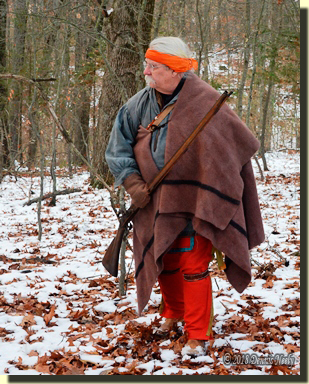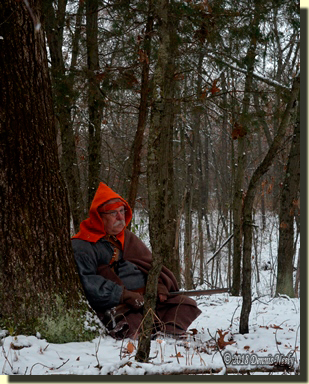Saturday, 17, December, 1763:
Eight Canada geese ke-honked, unseen and to the east. Orange, lavender and yellow marked the western horizon, beyond the Riviere aux Raisins. Snowflakes drifted all about. The air smelled stark and unforgiving. Mi-ki-naak’s nose dripped, but he gave no mind.
A deer pawed at crunchy oak leaves on the next ridge west. Honking all the while, the five by three wedge passed over the tall oaks and hickories atop Fox Hill. The geese flew north, circled once, then set their wings for a majestic descent to the still-open, sand shallows at the river’s bend. The young doe continued her search for acorns, giving the geese no mind.

A fox squirrel scampered along a large oak branch, working its way to the thin limbs at the tree’s drip line. Now and again, the bushy-tailed rodent knocked white fluff, accumulated on the branch tops during the afternoon’s squall, into the air. With a mighty leap, the squirrel flew to the next oak, the one with the torn-off limb. The critter clutched a frail twig, bobbed up and down, gained its footing, then continued on to a leaf nest, giving the deer no mind.
Not long after, a second antlerless deer wandered north. The deer eased around a raspberry patch, stepped over a rotted oak trunk and passed through the poplar trees. Still upwind of the hunter, who learned his craft from his adopted Ojibwe family, the young doe paused to browse. An opossum lumbered from behind a sassafras tree zigging south, zagging east, then back south. The deer gave the white and gray fuzz ball no mind, and the opossum did likewise.
As the daylight dwindled, the tenants of the forest went about their business, each with an appointed mission, each with a place to be, each with a place to go…
The Need for a ‘Rallying Point’
In his book, Some Thoughts on Scouts and Spies, Gerry Barker covers a number of topics relative to scouting and spying as a profession. Special Forces service in the U. S. Army mixes with historical research, bringing new insight to this shady endeavor. His 18th-century heroes are different than mine, to some extent, and maybe yours. And yet, his in-the-field experiences and the documentation that he draws together mirror those of my hunter heroes and my wilderness classroom lessons.
In a recent re-reading of his work, many of his comments have struck a note and/or tweaked my thought processes. While discussing necessary steps for maintaining a group’s “Security” he states:
“Finally, it is wise to arrange for emergency meeting points called ‘rallying points’ or sometimes ‘rendezvous,’ where the party can gather if forced to separate after a mishap. Amongst Major Rogers’ orders are the lines: ‘Each night you will be told where to meet up if the Indians attack and make us separate.’ This is a good system” (Barker, 29)
Now Mi-ki-naak, being captured by the Ojibwe, adopted by a Native American family and raised in their culture, might not fret about an “Indian attack”—or would he? Msko-waagosh should, as John Tanner, The Falcon, relates:
“Ais-ainse, the Ojibbeway chief, returned one evening from a successful hunt, having killed two elks and on the following morning, his wife with her young son, started out to dry the meat. They had proceeded a great distance from the lodge when the lad first discovered the Sioux party, at no great distance, and called out to his mother, ‘the Sioux are coming.’ The old woman drew her knife, and cutting the belt which bound the boy’s blanket to his body, told him to run for home with all his strength. She then, with her knife in her hand, ran to meet the approaching war-party. The boy heard many guns, and the old woman was no more heard of…” (Tanner, 159).

In December, 1763, the Siege of Detroit is history. In the lower Great Lakes region, near the headwaters of the Riviere aux Raisins, the British are still a concern. For Mi-ki-naak, an exception is the Lieutenant who mustered out of Joseph Hopkins’ Independent Company of Rangers.
James Smith, one of the returned captives used to source Snapping Turtle’s humble existence, makes no mention of rallying points. But John Tanner does, relative to a large group of Ojibwe and Cree engaged in a buffalo hunt:
“…eight men of whom I was one, were selected and despatched [sic] to kill some [buffalo], and bring the meat to a point where it was agreed the party should stop next night…” (Ibid, 106).
Now in most instances, my alter egos hunt alone. The rallying point is that individual’s campsite, with the ultimate goal of returning to the modern version of a homestead after dark. The trading post hunter has been a part of several group hunts. On three, maybe four occasions that I can recall, we all agreed on a rallying point, should we become separated. On the surface, a meeting place doesn’t sound likely, but on two occasions, the rabbit hunters split up and did not see the other party until we arrived back at the road as agreed.
Establishing a rallying point is not a make or break re-enacting habit, but rather one that should be considered when fleshing out a history-based persona. Barker points out the wisdom in a security sense for agreeing on a rendezvous, by location, day and time. John Tanner confirms the habit in a passing statement that leads a reader to believe, as Barker emphasizes, a common practice.
At the least, the notion is worth pondering…
Give traditional black powder hunting a try, be safe and may God bless you.



2 Responses to A Place to Be and a Place to Go